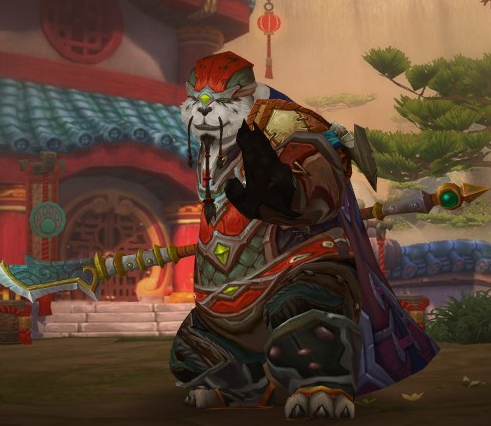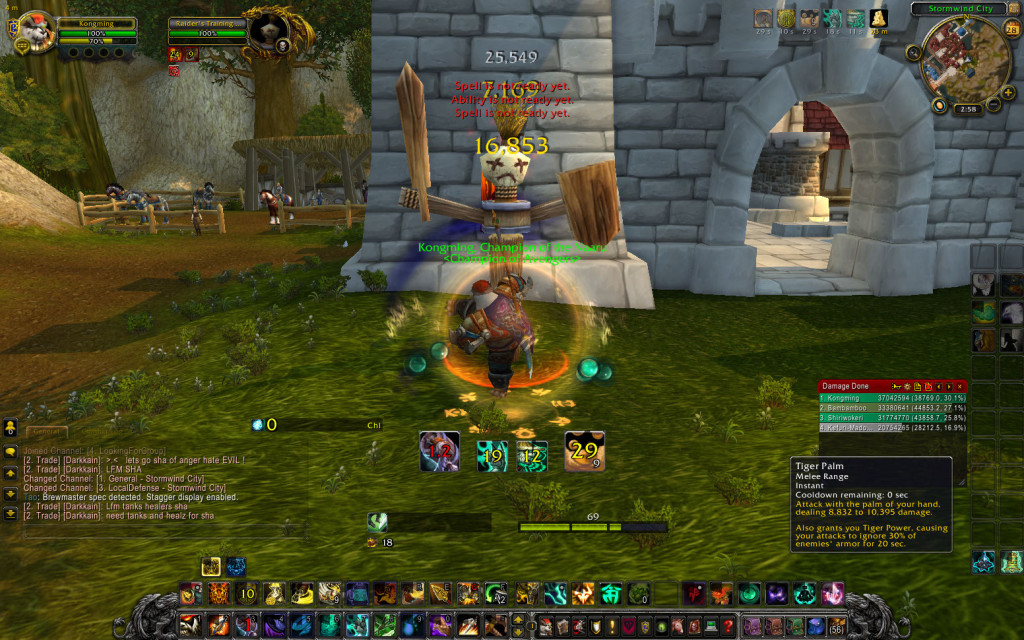Last updated on January 28, 2013
Man, do I love tanking! I’d say you should read this first, but feel free to continue without it. I gotta say: my Monk’s getting sexier everytime he gets new gear. As sexy as a fat anthropomorphic panda can possibly be, at the very least.

Honestly, though: I HATED playing the Monk as a tank when I first started delving into the nitty-gritty of the mechanics. There’s a perfectly valid reason for this, though: Monks require the most strict execution, the most spatial awareness, and the best reflexes to play well. This wasn’t clear to me at first, but playing Raid Finder a bit as a tank showed me what for, I can tell you!
I am used to the “traditional” form of tanking – gear well, show up, get hit repeatedly in the face, repeat. Monk does not do this in quite the same way. They’re situation and reactive tanks, suited to every situation but only if you know what’s happening. You don’t get a massive amount of armor or health from your gear, especially when you’re just starting out in the tanking realm, which puts you at a notable disadvantage. However, the Monk controls the damage they take at any portion of a fight – this is extremely strong, and makes tanking quite rigorous.
See, Monk tanks have a passive ability called “Stagger”, which turns any damage taken into a Damage Over Time Effect. However, it only defaults to 20% – a mere pittance when bosses take up to a third of your life, if not more on their special abilities. Thus, Monks also have a positive buff called “Shuffle” which activates when you use Blackout Kick. It gives you a huge avoidance buff for 5 seconds (30% parry, if my mind’s working right), but also increases your Stagger to 40%. Keeping Shuffle up on your character, then, remains a top priority.
However, one more ability really takes the cake here: Purifying Brew. This ability allows you to remove all Staggered damage you currently have. Imagine wiping away 40% of one’s damage at select points in a fight, and you can begin to see the undeniable power of the Brew. A raid boss about to hit you with a furious flurry of attacks? Simply wait for the hits, pop PB, and you live. Attacks that would flat out kill other tanks do not kill you! That’s pretty darn neat, if I do say so myself.
Monk tools run the gamut around this core ability set, from a cooldown (every 3 minutes) that lets you raise the Stagger to 80% for fifteen seconds, to 30% additional dodge chance for up to 15 seconds. Dampen Harm and Diffuse Magic, on the other hand, absorb huge hits of the physical and magical type, respectively (although you can only use one of those ability in a fight, due to them being on the same tier of the Monk talent tree). All of them require your utmost care and attention throughout any encounter. There’s always a right answer and a right reflex to any particular encounter, but that requires time and muscle memory to make all these different elements coalesce. I mean, just look at this:
Most of those icons plastered on the screen derive from various addons, but I need these to track what’s happening. To put it in English: I have Keg Smash 1.2 seconds from coming off cooldown (it’s an Area of Effect attack that place a debuff that gives enemies a chance to hit themselves – nice), nine seconds from losing extra attack power from Tiger Palm, twelve seconds from losing Shuffle, and twenty nine seconds of Elusive Brew (the aforementioned dodge buff). I can see the energy bar on the bottom right, and the Stagger bar on the bottom left (it will actually show how much damage I am Staggering, and what percentage of my health that Stagger actually constitutes). Chi, used for many special abilities and generated by Jab, Keg Smash, and Expel Harm, is shown to the left. That’s a lot of stuff to monitor!
It doesn’t help that Monks are exceedingly mobile, having Roll and weird charge techniques. As well, they generate self healing orbs using Gift of the Ox (which just generates them based on whether you damage something or not), which can work well in a jiffy. Running into 5-6 healing orbs after a big whack takes some pressure off your healers. And on that note, healers need to adjust to how Monks takes damage, and that isn’t easy. The DoT factor really changes how much overall damage you can take in any one instance, and this isn’t like any other tanking class.
I’m not opposed to this complication in a video game; it presents more options, creates more challenging, and makes winning much more satisfying than it would be otherwise. By the same token, however, It’s times like these that I’m glad that Christianity, at heart, is indeed simple. Sure, there’s a vast number of complexities to the whole structure, but the message is so basic and so utterly astounding that people have a hard time believing it. Maybe we like complexity because it masks the issues that really face us. To live in self-deception remains an easier path than taking a good long look at yourself and seeing the simple answer smacking you in the face. Or, as Chesterton might say:
The Christian ideal has not been tried and found wanting. It has been found difficult; and left untried.
Jesus says in Matthew 11:
…“I praise You, Father, Lord of heaven and earth, that You have hidden these things fromthe wise and intelligent and have revealed them to infants. 26 Yes, Father, for this way was well-pleasing in Your sight.27 All things have been handed over to Me by My Father; and no one knows the Son except the Father; nor does anyone know the Father except the Son, and anyone to whom the Son wills to reveal Him.
28 “Come to Me, all who are weary and heavy-laden, and I will give you rest. 29 Take My yoke upon you and learn from Me, for I am gentle and humble in heart, and you will find rest for your souls. 30 For My yoke is easy and My burden is light.”
This is the kind of thing that motivates me to work as hard as I can. God took care of all the hard stuff already. Now I just need to make the adjustments necessary to live up to the Christian ideal and the easy answers it brings.
That remains as true for tanking as anything else. I found that I had been playing the Brewmaster style entirely wrong, wasting Chi and precious cooldowns. If anything, World of WarCraft encourages efficient play, and that was not happening at all. Blizzard designed the Monk much like Bruce Lee would do Jeet Kune Do:
Don’t get set into one form, adapt it and build your own, and let it grow, be like water. Empty your mind, be formless, shapeless — like water. Now you put water in a cup, it becomes the cup; You put water into a bottle it becomes the bottle; You put it in a teapot it becomes the teapot. Now water can flow or it can crash. Be water, my friend.
Like most tanking classes, Brewmaster requires adaptation. Whatever situation you encounter, you must adjust and adapt your tanking strategy. Monk requires a tighter focus, though, on dealing with whatever adverse situation or new problem that occurs throughout any single encounter. Use the tools you have, master the mechanical complexities, and everything becomes simple immediately. You just need to use the right tool for the right situation. In other words, identify the simple problem hampering your success and fix it.
So it is in video games, so it is in real life.

